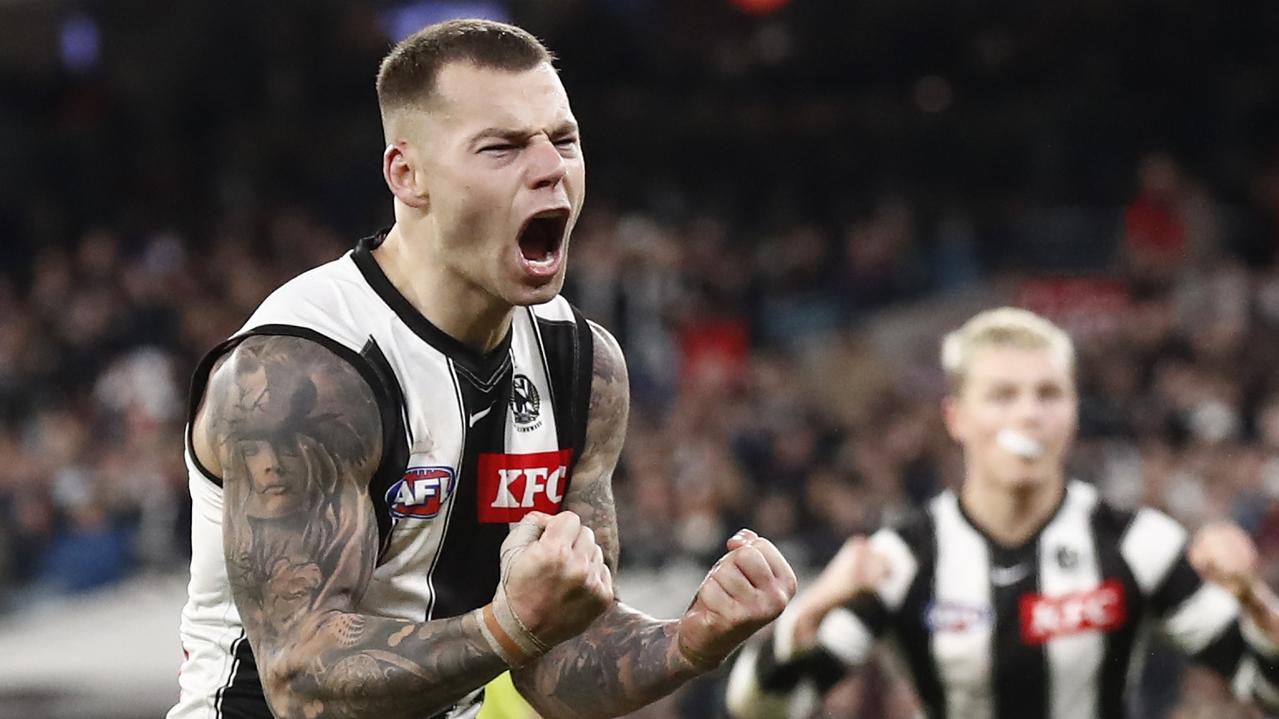Mick Malthouse: New rules favour the attacking teams and are being exploited by ladder leaders
Mick Malthouse has taken almighty swipe at some of the ‘ridiculous’ new rules, claiming they threaten to leave a vast chasm between those who can exploit them and those who cannot.
All the talk in town is Collingwood, and for good reason.
The Magpies are playing exciting footy, which is desirable to watch. Their game structure is high-pressured to cause turnovers, and all heart, coupled with some highly skilled ball-magnets and deliverers, so if anything is going to beat them it’s just the time clock, and that has supporters glued to the edge of their seats.
Footy at this time of year is infinitely more exciting as the top eight takes shape.
Adding further intrigue is how teams can capitalise on the new rules — if there is any advantage to be gained at all.
It’s no coincidence that Geelong and Collingwood are top two on the ladder, in the way that they are each able to use their strengths to exploit the newer rules.
Watch every blockbuster AFL match this weekend Live & Ad-Break Free In-Play on Kayo. New to Kayo? Start your free trial now >
KICK-IN RULE SO FLAWED
The kick-in rule is absolutely flawed.
There is a “square” to kick from, so why are we still allowing a player to run 15-20m before disposing of the ball?
It is far too much of an advantage for the attacking team. The man on the mark still resembles a lamp post and the defending team is basically down to 17 players.
If you can’t defend a kick-in you can’t control your game. So the disciplined clubs generally push up and have a secondary defensive layer to limit the distance that the attacking side can advance the ball.
The Magpies also utilise the rule as the attacking team, and there isn’t a better example than against Essendon in round 19 when they won with an after-the-siren kick by taking free licence to run the ball out of the goalsquare and kick quickly downfield to catch out the sleeping Dons.
That’s how you take advantage of a ridiculous rule.

STAND-ON-MARK MADNESS
Speaking of ridiculous rules, the stand-on-the-mark rule is right up there. However, the top teams that are better prepared and diligent on the mark and sweat on the umpires calling play on at the appropriate time, to pounce. Collingwood does this.
The Dogs, on the other end of the spectrum, fall off the mark and try to put another defender in front of the ball, thereby taking away the lamp post. Both can be effective, but both can also be flawed.
6-6-6 NUMBER OF THE FEAST
Another bee in my bonnet is the 6-6-6 set up. You will never get me onside with this rule, unlike so many former key forwards-now-commentators who know that the rule favours the teams with the strongest midfields and the best key forwards.
Whoever gets the ball out of the centre is going to score. Because if you’ve got a good ruck and midfielders and a strong forward set up, without an extra defender to intercept or provide extra pressure, the attacking team has it too easy and the defending team is at the mercy of a quick ball entering the 50m zone.
When Geelong clears the ball quickly from the centre — and its pace of ball movement is one area it has improved on this year — it has Tom Hawkins and Jeremy Cameron, one-on-one, as targets. So, the Cats will almost always score from it.
For those quipping that Harry McKay has gone missing at Carlton, they need to look at the Blues’ midfield. Since Carlton’s best defensive midfielder, George Hewett, got injured, its midfield output has declined, and so too its ability to clear the ball and dispose of it to McKay and Charlie Curnow. The Blues are no longer able to take full advantage of the 6-6-6 set up, and it’s hurting them.
Brisbane doesn’t really use it good enough with the quality midfield and forwards it has.
Perhaps that will change in the finals.
Collingwood has a fighting forward line, so the set up will suit it if it can get the ball out of the centre quickly.

Melbourne benefited from it all of last year with Max Gawn, Christian Petracca and Clayton Oliver in the middle and a fit Tom McDonald and in form Ben Brown forward.
The 6-6-6 rule has made for an unfair playing field, where the coach’s hands are tied. Let him decide if he wants an extra man behind the ball or in front of it.
Surely supporters have the right to think that their team has the ability and the chance to defend the ball coming out of the centre.

BETTER TEAMS CASHING IN
There are only three ways to score in footy — from stoppages, turnovers, and kick-ins. All of the newer rules favour the attacking team, and the already better teams.
It’s time to change the rules back to the way they were and have been for over 100 years.
Thank goodness the dissent rule has been watered down. After a typical reaction to a new rule that is initially overpoliced, the umpires have adjusted by design, or for personal pride, and there isn’t more or less dissent than any other year.
When we wonder where all our spectators have gone, we can’t keep blaming Covid.
The AFL likes to spruik big crowd numbers (for games between the bigger clubs) but forgets to mention the lower ones.
It’s embarrassing how many people don’t go to the footy anymore, particularly when we are on the cusp of a finals series where we are glued to the results to find out who is going to make the top eight — and in what order.
That’s where all the current interest and excitement is.

RULES HAVEN’T WORKED
The diversity of the teams fighting for the top eight is incredible, not only in styles, but in the type of players competing.
No one works harder than Collingwood.
Geelong has defied age and improved with a subtle change to its game style and pace of ball movement.
Melbourne is still dangerous but leaves it up to too few.
Brisbane and Sydney are equally as brilliant as they can be poor at times.
Michael Voss’s high-intensity game plan at Carlton has evaporated, and the Blues need to find their fight again or they’ll be looking at another could-have-been season.
The Tigers are still hanging in there.
With all due respect to former AFL football operations boss Steven Hocking, who was thinking laterally when he introduced the new rules, they haven’t worked. Yes, some clubs can optimise them, but only marginally, not enough to keep them in the game.
With one round left, and finals, footy is highly entertaining again. May we revisit the past, and common-sense rules, and let it stay that way.






